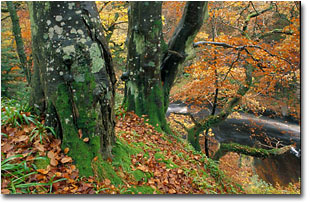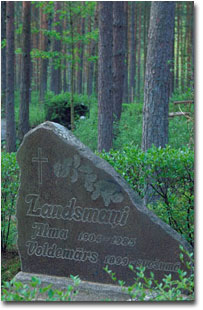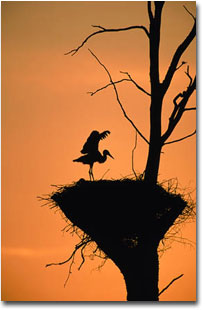|
|
 The Edge
Text and photography Copyright Niall Benvie
Let's return to that wolf. Here is an animal at the edge. He, Buster, is living in a geographically isolated area - northern Ellesmere in arctic Canada - well away from any centres of human habitation. The ice floe is neither quite land nor water, but something in transition from one to the other. The viewer has to wonder what has driven the animal into this apparently perilous situation (although I suspect that some food may be implicated...). Even the lighting is ambiguous - we seem to be in the zone between night and day. This picture perfectly exemplifies why the edge is such a powerful theme in many of the most compelling images of the natural world. The edge, defined, is a zone of transition in time or space or being. Put more simply, it is where change occurs and contrasts arise. Our visual system is set up to respond to these stimuli; present it with a static scene and it will switch off after a while. If "zones of transition" sounds a bit nebulous to you, consider the topics that most nature photographers work over and over again; dawn and dusk (the edges of the day); autumn and spring (the transition between seasons); seascapes and silhouettes (the edge between land and sea and between land and sky); baby mammals and the old males (representing the edges of life); animals such as penguins and marine iguanas living in extreme environments (places where the gap between life and death seems narrow). These are all images from the edge, away from the usual, familiar or mundane. They are pictures about "the most" and most of us find them irresistible. In our photographic search for the edge we are satisfying other instincts too in our role as endlessly curious primates.
The edge is also where the struggle between wildness and culture, between anarchy and control is fought. It seems to me that in this country there is a cultural determination to infantilise our relationship with wild nature, to cosset and protect us from it, to make it safe and palatable. The need to take responsibility for our actions therefore diminishes and with it our appreciation of the power of nature unmediated by man. To that end, we are often prevented access to the edge - to visit places in the gloaming, or to go to the cliff edge because a protective fence. When I was asked recently to complete a risk assessment form for doing some work with my floating hide on an eastern estuary, I was tempted to reply by saying that I couldn't assess the risk until I'd taken it, that I "couldnšt see the ocean for the dunes. " Is this really something to concern outdoor photographers? Well, it depends on how happy you are with second best, whether you can settle for the dunes or if you want to walk through the surf. If, like me, you are driven by a powerful urge to create then denial of access to the edge matters a great deal; I doubt if any of us is content to produce pictures which we know we could have done better.
While the concept of edges celebrates the most extreme contrasts in the natural world, complexity is pre-occupied with its connections. What is going on beyond the picture is every bit as important as what appears in the picture itself; the job of the photograph is to get the viewer to speculate about where it fits into a bigger story. A "complex" composition rarely has the immediate impact of one which appeals to our interest in the edge; the image is often more modest in its scale and less visually dramatic in content. The subject may not be immediately apparent and indeed several may vie for attention. But if they are successfully executed, complex compositions can have a more enduring interest. Sometimes the label "complex" is applied to a photograph which would better be described as "banal"; arty-sounding labels are always good places to hide behind. A complex composition has a story to tell and if the viewer is unable to read it, then the photographer should be willing to help; if it really is banal, then there is nothing to tell. But sometimes the content of a picture really can be greater than the sum of its aesthetic parts. Just as it is unjustifiable to dismiss all abstract painting as worthless because it is not immediately accessible to everyone so too we should take time to think about what we see in a complex composition, to figure out if the photographer is trying to link it into a broader set of relationships, or simply conning the gullible and irritating the informed. About the images Wet beech trees, Gannochy Gorge, October. Although this picture seems to fall into the "edges" category, there is rather more going on than a casual glance might suggest. The highly saturated colours of the beech leaves and moss on the tree trunks hint at recent heavy rainfall, proof of which is to be seen in the fast flowing river below. The river is heavily peat stained suggesting that we are perhaps in the north or west where higher rainfall leads to peat accumulation; so who planted these beech trees (native in the UK only to the chalky downlands of the South) and why? The fact that it is the north - mossy - sides of the tree that are so wet suggests something of the air temperature too; it was raw. Nikon F4, 28mm, Fuji Velvia. Grave of a disappeared man, Laciepes kape, Latvia. In this tranquil spring- time scene on the outskirts of Riga we can read a personal tragedy in the troubled history of Latvia in the 20th century. While the year of the birth of Voldemars Landsmanis is given (1899) "svesuma" - translating roughly as, [to a] foreign, or strange land - hints that like so many other Latvians, he was deported by the Soviets, never to be heard of again, and the year of his death, unrecorded. Non-Latvian speakers (of which I am one) are excused for needing the explanation... Nikon F4 90mm, Fuji Velvia. White stork at dusk near Latgale, Latvia. Here, two edges themes, one in space- where the land meets the sky - and one in time - where day turns to night - co-incide. We do not need to think about the content of the image; our response is purely instinctive. Nikon F5, 500mm + x1.4 converter, Provia 100F. Niall Benvie - NPN 018 Comments on this article? Send them to the editor. |
|
|
 Why do some pictures cause a spark in our limbic systems while others
provoke no emotional response at all? What is it, for example, that makes,
Jim Brandenburgšs picture of an arctic wolf jumping between ice floes such
an iconic image - one whose appeal extends well beyond the ranks of nature
photographers? Over the years I have tried to rationalise my response to
other peoplešs photographs, as well as my own, trying to identify a formula
for great pictures. It has, of course, been a futile analysis, but one which
has turned up the closest thing to a unifying theory for provocative imagery
that we are likely to get.
Why do some pictures cause a spark in our limbic systems while others
provoke no emotional response at all? What is it, for example, that makes,
Jim Brandenburgšs picture of an arctic wolf jumping between ice floes such
an iconic image - one whose appeal extends well beyond the ranks of nature
photographers? Over the years I have tried to rationalise my response to
other peoplešs photographs, as well as my own, trying to identify a formula
for great pictures. It has, of course, been a futile analysis, but one which
has turned up the closest thing to a unifying theory for provocative imagery
that we are likely to get. There are two conflicting forces at work here. On the one hand, innate
curiosity demands that we discover how far we can go, what are our own
limits. This is perhaps why we gravitate towards the edge of the sea (always
more exciting in a storm) rather than walk at the foot of the dunes; why we
need to peer over the edge of a cliff or get to the summit of a mountain;
these are edges in space. At the same time, it is drummed into us from
childhood to "Keep back from the edge. Itšs dangerous." We learn to be
responsible and to choose the safe option. Yet our wild side sometimes
rebels, urging us to "live dangerously", perhaps informed by the deeper
understanding that there is no second chance - that we have only one life.
And so, as Peter Matthiessen describes in The Snow Leopard, "Perhaps this
dread of [the] transience [of our lives] explains our greed for the few
gobbets of raw experience in modern life...We cling to such extreme moments
in which we seem to die, yet are reborn." (p227) In other words, we need to
be exposed to danger before we can feel fully alive. In creative terms, this
translates into the need to experience nature at its most extreme and to
validate that experience by producing a photograph of it.
There are two conflicting forces at work here. On the one hand, innate
curiosity demands that we discover how far we can go, what are our own
limits. This is perhaps why we gravitate towards the edge of the sea (always
more exciting in a storm) rather than walk at the foot of the dunes; why we
need to peer over the edge of a cliff or get to the summit of a mountain;
these are edges in space. At the same time, it is drummed into us from
childhood to "Keep back from the edge. Itšs dangerous." We learn to be
responsible and to choose the safe option. Yet our wild side sometimes
rebels, urging us to "live dangerously", perhaps informed by the deeper
understanding that there is no second chance - that we have only one life.
And so, as Peter Matthiessen describes in The Snow Leopard, "Perhaps this
dread of [the] transience [of our lives] explains our greed for the few
gobbets of raw experience in modern life...We cling to such extreme moments
in which we seem to die, yet are reborn." (p227) In other words, we need to
be exposed to danger before we can feel fully alive. In creative terms, this
translates into the need to experience nature at its most extreme and to
validate that experience by producing a photograph of it. Pursuit of edges is a highly instinctive approach to nature photography and
successful pictures generally appeal to us on this level; they don't require
much analysis or explanation. Their appeal is visceral rather than
intellectual. But there is another quite distinctive approach, one which
acknowledges a desire to be told stories which, for the sake of
differentiation, we'll call "complex".
Pursuit of edges is a highly instinctive approach to nature photography and
successful pictures generally appeal to us on this level; they don't require
much analysis or explanation. Their appeal is visceral rather than
intellectual. But there is another quite distinctive approach, one which
acknowledges a desire to be told stories which, for the sake of
differentiation, we'll call "complex".